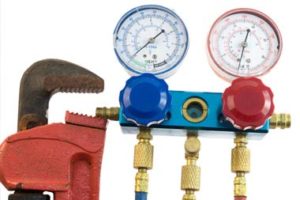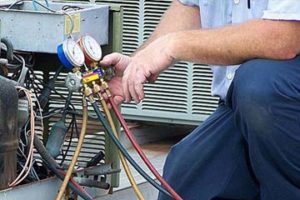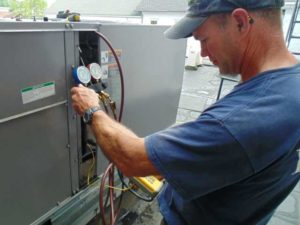 If an owner expects his refrigeration equipment to perform reliably for many years, preventive maintenance is an absolute necessity.
If an owner expects his refrigeration equipment to perform reliably for many years, preventive maintenance is an absolute necessity.
When equipment constantly breaks down or doesn’t perform to expectations, it’s often because there has never been any preventive maintenance — only emergency service. Remember, equipment is only as good as the service performed on it.
All mechanical equipment needs periodic service to keep it in the best operating condition. Good service can mean the difference between a few mechanical malfunctions or continuous problems.
Refrigeration Preventative Maintenance in the Perth Metro
The following is a guide to developing a comprehensive preventive maintenance program.
To properly maintain a system, all the major components should be included in the maintenance schedule. These include the evaporator(s), compressor unit, and condenser.
Evaporator Preventative Maintenance
Check the evaporators monthly for proper defrosting. Ice accumulation on the evaporator coil can cause inefficiencies in the operation of the system, and can be detrimental to the coil surface itself.
Every six months:
1. Tighten all electrical connections in the electrical panel.
Check for frayed wiring insulation and corroded terminals, and make certain all spade connections are tight.
2. Check fan motors and blades.
Do the blades turn freely? Check the blades for unusual wear patterns or stress fractures. Clean the surface of each fan blade. Replace any worn blades and tighten the fan set screws.
On motors with lubrication fittings, apply the correct lubricant. Replace any motor that is hard to rotate or has worn bearings.
3. Check all defrost heaters.
Make certain heaters are in the correct position for maximum heat transfer to the evaporator coil. Follow the manufacturer’s recommendations.
Check each heater for correct amp draw.
Check the voltage at each heater terminal.
Make certain the heater terminals are in good condition.
4. Clean the drain pan and check for proper drainage.
All foreign material should be removed from the drain pan. The pan should drain freely.
The drain line should be free-draining with visible slope away from the evaporator.
Check the drain line heater in applications below freezing.
5. Clean the evaporator coil surface.
The coil should be washed periodically to remove dust and other foreign materials that might have been drawn into the fins. A commercial-grade cleaning foam can be used. Follow the label directions of the appropriate cleaner to clean refrigerant coils.
 Compressor Unit Maintenance
Compressor Unit Maintenance
Every six months:
1. Tighten all electrical connections.
Check for frayed wiring insulation and corroded terminals. Replace damaged wiring.
Make certain all spade connections are tight.
2. Check all electrical components.
Electrical contactors should be inspected closely for worn and pitted contact points. The points should be cleaned and polished. Check for any discoloration in the conductors, which may indicate a loose wire or a dangerous over-current condition. Any foreign material found in the contactor should be removed.
Inspect the defrost timer motor. Clean the contact points and lubricate the gears of the clock. Make certain the entire clock mechanism rotates freely.
Check all relays for worn points; replace relay if necessary.
Check the electrical connections inside the compressor electrical box.
3. Check the operation of the control system.
Check all pressure controls for proper operation and set-points.
Check the safety controls. Make certain the oil safety and high pressure controls are functioning.
Check the operation of the room temperature thermostat. Make certain the liquid line solenoid valve closes completely and the compressor pumps down and cycles off.
4. Check the oil level in the compressor.
The oil level should be at or between one-third and two-thirds of the sight glass.
Check the operation of the crankcase heater.
5. Check the operation of the defrost controls.
Under most conditions, the timer should initiate the defrost. Make certain the defrost termination temperature control stops the defrost cycle and allows the evaporator fans approximately 2 min of delay time before restart.
6. Check the condition of refrigerant line insulation.
Open, torn, or waterlogged insulation provides little benefit to the system. If the insulation is in poor condition, replace it.
7. Check for the proper refrigerant level in the system.
The liquid line sight glass should be clear and full of liquid refrigerant during normal operation. If not, find and repair the leak, then charge enough refrigerant into the system to maintain a clear sight glass.
8. Check the system super-heat at the condensing unit.
Suction super-heat should be checked at the compressor as follows.
a) Measure the suction pressure at the suction service valve of the compressor and determine the saturation temperature corresponding to this pressure from a temperature-pressure chart.
b) Measure the suction temperature of the suction line about 1 ft back from the compressor using an accurate thermometer.
c) Subtract the saturated temperature from the actual suction line temperature. The difference is super-heat.
Too low a suction super-heat can result in liquid being returned to the compressor. This causes dilution of the oil and eventual failure of the bearings, rings or, possibly, valve failure.
Too high a suction super-heat will result in excessive discharge temperatures, which cause the oil to break down and result in piston ring wear and piston and cylinder wall damage.
For maximum system capacity, suction super-heat should be kept as low as practical. (CCR recommends the super-heat at the compressor be no lower than 30°F.) If adjustments to the suction super-heat need to be made, the expansion valve at the evaporator should be adjusted. Follow the manufacturer’s recommendations.
9. Check all capillary and super hose lines for signs of wear.
Make certain all capillary and super hose lines are secure and do not rub against objects that can cause refrigerant leaks.
10. Replace all missing valve caps and unit covers.
 Condenser Maintenance
Condenser Maintenance
Every six months (sooner if local conditions cause clogging or fouling of air passages through the finned surface), perform the following:
1. The condenser coil should be cleaned and washed.
Clean periodically with a brush, vacuum cleaner, pressurized water, or commercially available coil cleaning foam. If a foam cleaner is used, it should not be acid based. Follow the label directions of the appropriate cleaner.
2. Check the operation of the condenser fans.
Check that each fan freely rotates.
Tighten all fan set screws.
Check the fan blades for signs of stress or other wear features. If any unusual wear is seen, replace the blade.
Lubricate the motors if applicable. (Most condenser motors are permanently sealed and do not require lubricating.) Replace any motor that is worn.
Important: We fill out a maintenance log and leave it with the owner or with the equipment after each periodic inspection. This log should be available for future reference. It is also advisable to retain a copy of the operating parameters at the time of the inspection.
Call Greg now for all your refrigeration preventative maintenance needs on 0405 196 403.

